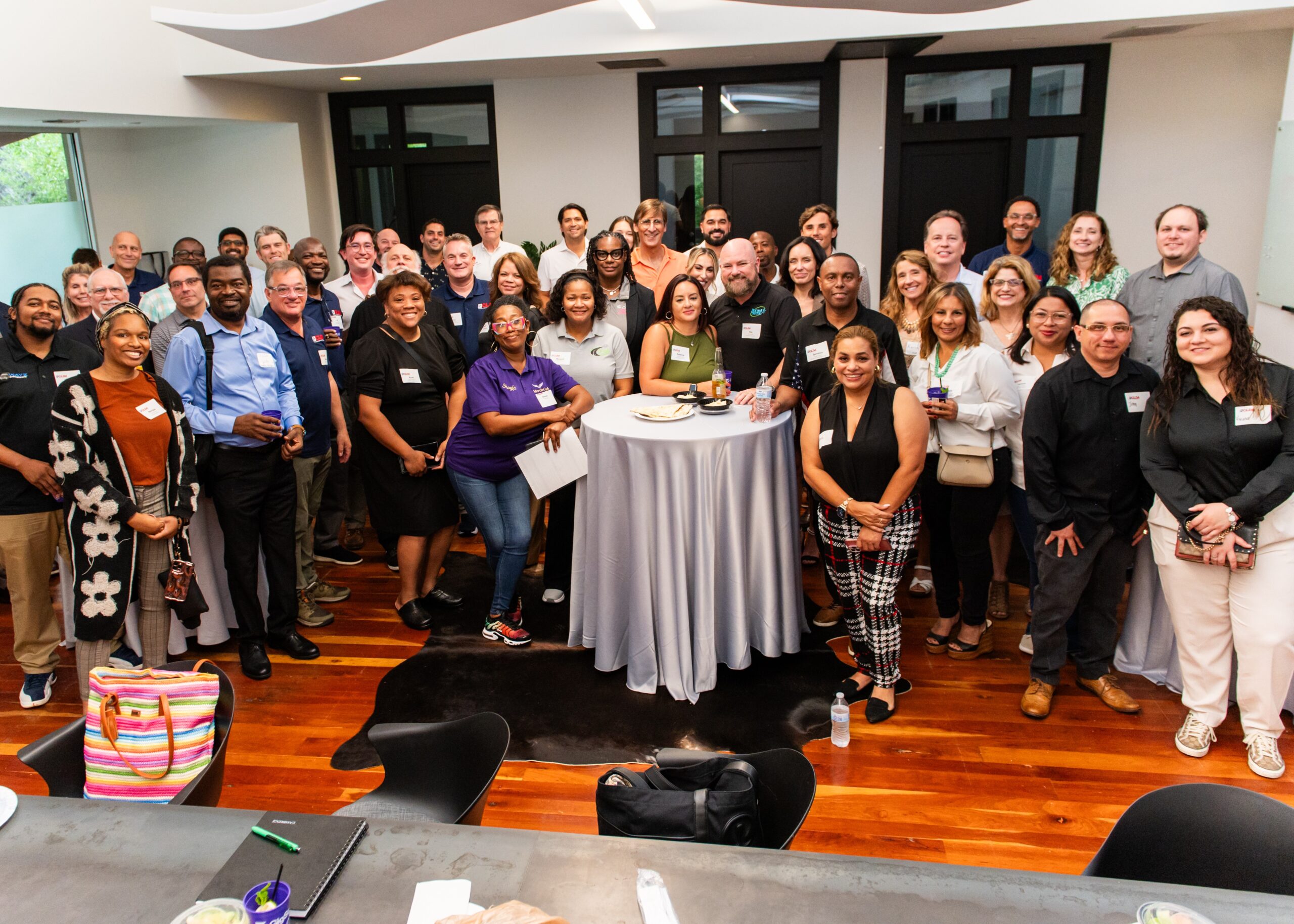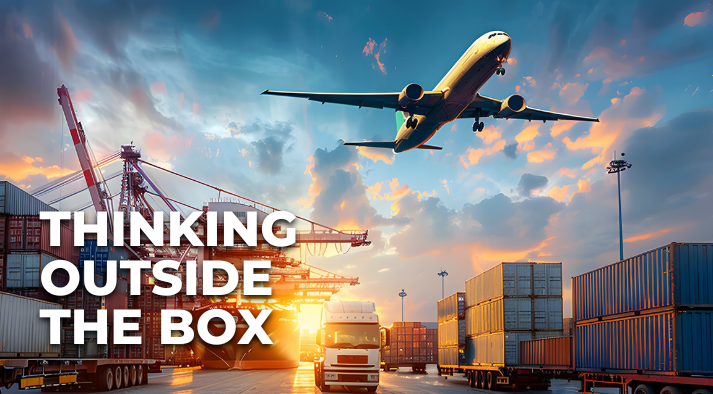











CLDA Members are encouraged to share news about their company. CLDA may share on social media, in newsletters or the Customized Logistics & Delivery Magazine.

Ready to share your news with CLDA or the industry media? Learn from these tips and tricks on how to get noticed.


This year’s holiday peak delivery season will start earlier, putting more pressure on last-mile providers than ever before. That was the prediction of CLDA Board Member, Ruth Correa. This will be her 17th holiday season in the logistics space, and she expects this to be one to remember.
Correa founded two last-mile providers, Tempo Couriers in 2008 and Cheetah Final Mile LLC in 2022. She is the CEO of Cheetah Final Mile, a transportation services company operating in Missouri and Tempo Courier in South Florida. The company focuses on same-day logistics, warehousing and outsourced transportation services. “Thinking Outside the Box” asked her for her thoughts on the upcoming holiday peak delivery season.
Earlier Start to the Holiday Peak Delivery Season
“Because of tariffs, a lot of retailers frontloaded what they bought in before the tariffs took effect,” Correa points out. “I think that will affect when the sale of those items begins this year. Even though the calendar suggests it should be a shorter holiday season, I don’t think that will hold true. I predict retailers will start holiday sales a lot earlier than in the past.”
For carriers, that means they’ll need to prepare for the peak holiday season earlier than ever before. “Everything is going to happen earlier,” she says. “We carriers are going to have to be flexible on the start of the peak season,” she says. “That means, right now, we should be looking at past data to help us optimize routes and reach more points in less time.”
Preparing Now
Correa advises couriers to take immediate action to prepare for peak season. “This is the calm before the storm,” she says. “At our company, we’re doing a lot of cleanup. We’re ensuring that all returns are taken care of. We’re freeing up floor space in our warehouses. We’re also cleaning up our equipment and replacing any that can’t do the job we need.”
On the people side of things, Correa suggests using this time to onboard new drivers. “You want to make sure you have enough drivers ready for the season ahead of time,” she advises. “They need to be onboarded correctly now so that when the time comes, you have a good pool to pick from.”
She also suggests taking a good, hard look at ways to improve efficiencies through technology. “If you’re going to bring in new technologies to improve your processes, now’s the time to start and to get your team trained to make the most of it when peak arrives, whenever it does,” she says.
She points out that while communication is always key, it becomes even more critical during the holiday season. “People have heightened expectations during the holidays because they need to know their items will arrive before Christmas Day,” she points out. “So now is the time to make sure that your processes and your technology are running correctly before that moment arrives. Whether it’s your customer, the shipper, or their customer, the consumer—everyone wants to see where their packages are and where they are along the way. That’s where technology comes in. If you have the right technology in place, everybody has visibility. That’s going to lessen the number of people you need in the office and the number of emails and phone calls you will need to respond to.”
Reach Out to Shippers
Correa expects to reach out to her regular customers starting in October to gather their estimates of what they expect from her company during the peak season. It’s something she does every year, but this year she’ll be doing it earlier. “At the beginning of October, we will be reaching out and seeing what kind of pipeline to expect from our customers,” she says.
Words of Advice
Correa offers these words of wisdom to help last-mile providers weather Holidays 2025:
1) Sleep now because you won’t be sleeping later.
2) Preparedness is key. You cannot be too prepared. Have more than you need.
3) Make sure your technology is up to speed; that everybody knows how to use it, and knows how to make the most of it.
4) Automate as much as you can.
5) Understand route optimization.
6) Add enough independent contractors to your pool now. Ensure that they’re onboarded and that you have all the necessary paperwork. Test them on routes before peak starts, so it’s not their first time during peak.
7) Have the right equipment in place to meet the need and flex when needed.
8) Train your in-house team to meet your customers’ expectations.
Correa sums it up this way: “It’s going to be interesting to see what the consumer does this holiday season. Will the tariffs raise prices enough to curtail sales? Will retailers start offering deals earlier than usual? I know the calendar says the season is supposed to be shorter, but I’m expecting it to start earlier. So what will that mean? Whatever happens, my biggest advice for carriers is to be ready to be flexible. That’s always been the strength of those in this part of the supply chain. I expect this year to be a real test of that resilience.”

What are the insurance issues impacting those in the final mile? And how can carriers manage risk?
“Thinking Outside the Box” recently interviewed Bryan Paulozzi, Vice President, Risk Strategies, part of the Brown & Brown team, to get his take on the industry today and tomorrow. Bryan and his team at Risk Strategies have been involved in risk management and insurance for those in the supply chain for over two decades.
What are some of the unique risks those in the final-mile are facing?
A lot of it is related to their use of 1099s. There are some unique risks when it comes to this sector’s use of subcontractors. These drivers are using their own vehicles to do deliveries. That’s a challenge because insurance company underwriters do not easily understand this model.
Things become even more challenging when carriers use a combination of employee and 1099 drivers. They have a fleet of vehicles that presents its own risk profile. Those hybrid risks really become challenging when it comes to insurance. Suppose we have a courier company with 20 box trucks and vans on the road, and they have 1099 drivers operating under the same authority. In that case, few insurance carriers understand and are willing to cover them.
Traditional insurance players like Allstate or Travelers don’t want to underwrite these types of risks. So when we’re working with companies like those involved with the CLDA, we often have to go into the specialty market to find coverage.
We’ve heard a lot about the changes in the marketplace, especially with the growth of e-commerce and rising consumer expectations. How have those expectations had an impact on the insurance and the risk management end of things?
Ever since COVID, the visibility of the services of those in the last-mile industry has put a spotlight on this sector of the supply chain. They are now on the radar for insurance carriers. Insurance underwriters have become more aware and attuned to it. And they are pulling back. They don’t want to deal with the unique risks in this sector. That’s tightening the underwriting market from that capacity.
In addition, if you look at how the model’s been built, using 1099 drivers who use their own cars or vans, and pickup trucks, that’s a problem. They have been using their personal auto insurance. Uber and Lyft have really shone a light on people who moonlight with their vehicles to deliver passengers and packages. We refer to that as the “uberization” of the industry. That’s not what personal auto insurance was intended to cover. If these drivers cause an auto accident, it’s questionable whether their personal auto insurance will respond to the claim. When that happens, claimants are looking to the dispatching courier company for restitution, sometimes even bypassing the 1099 driver altogether.
Furthermore, personal auto insurance carriers have gotten wiser when it comes to claims. One of the first questions they ask is “Were you making a delivery when you had this accident?” More and more, these claims are making their way up to the courier company. This is creating one of the biggest challenges facing this industry in terms of non-asset exposure is finding non-owned and hired auto insurance or contingent auto liability that insures their risk at an acceptable price for the courier company.
How about the impact of technology? How has that affected insurance and risk management for last-mile providers?
Technology is good when utilized appropriately. Often, companies have telematics, dash cams, or face cameras. These are excellent when it comes to creating a proper risk management structure for a company’s driver network. When they use the data they collect appropriately and follow through on what it tells them, these can be great tools. They help companies make sure the drivers they use are doing their jobs safely. And when this technology pinpoints a problem, smart companies work with the drivers to correct any issues.
On the other hand, those who have the technology but fail to utilize the data could face issues when a claim is made. If the technology shows unsafe behavior and a claimant’s attorney gets hold of it, that could be a problem.
What is the biggest misconception last-mile companies have about risk management?
Their most significant area of exposure is the use of independent contract drivers. Due to the sensitivity surrounding the IC model, many believe they cannot impose constraints on their drivers’ behavior regarding safety. However, just because they’re 1099s, it doesn’t mean there can’t be some form of enforcement when drivers engage in unsafe behavior. If companies notice that a 1099 is underperforming, based on the tracking mechanisms they have in place, they should take action. And if the driver continues the behavior, it’s the carrier’s prerogative as a business owner to say, “I’m no longer going to give you my work.” They have the right to choose who they work with, and they certainly want to contract with good performers.
The other misconception is around work injury coverage. That’s often something that’s overlooked for 1099 drivers. I can’t tell you how many times we’ll hear from customers that it’s not their problem if a driver gets hurt on the job. “Work injury is something they handle on their own; they are not our employees,” they tell us. But that’s not necessarily true, because anyone can sue anyone for anything. And if that 1099 does get hurt while hauling a load for you, he has the potential to try to sue you for workers’ comp as an employee. Often, this gets overlooked because courier companies think, “I only worry about my W-2s and I’ve got a workers’ comp policy to cover them.” However, there have been instances where 1099s have pursued the carrier company’s workers’ comp coverage, which can become a significant issue.
What can a carrier do to control risk?
When you talk about risk management, the most crucial thing is driver hiring practices. You’ve got to have the appropriate driver hiring practices in place.
You have a driver grading system. You have to follow through on that. I suggest you pull these reports more frequently than in prior years. That’s the first part of having a process in place to put good drivers on the road.
The next part is tackling the whole concept of the use of personal auto insurance. Understand that when you’re using 1099s who are relying on their personal auto insurance, your company is bringing yourself one step closer to the fire in the event of a loss. There’s a commercial insurance product that’s been around for 20 years that can help here. It’s called While Under Dispatch auto insurance. It provides an additional layer of coverage. Basically, it’s commercial auto insurance for 1099 drivers, covering them while they’re on dispatch. Once the driver accepts work from the company, they are covered by dispatch insurance in the event of an auto accident. I believe couriers will often find themselves in situations where this is necessary at the driver level to help create insurability for them at the corporate level. Many hired/non-owned auto insurers who are willing to underwrite courier companies are growing less fond of the whole personal auto exposure. I think over the next 12 to 24 months, we’re going to see more use of this kind of coverage. I’d advise all courier companies to start looking at this because I can foresee a time when the carriers will require something like this to secure commercial coverage of the operation.
It sounds like the environment keeps changing. How does a carrier make sure they are keeping up with those changes?
You need to work with an insurance agent who’s experienced in this arena. Last-mile carriers are unique. There are only a handful of insurance brokers in the country who know how to handle these operations.
You want to work with an agent who will be your advocate. At Risk Strategies, we’ve been specializing in this industry for the last 20+ years. It’s all we do. So we know the questions these business people have. We know how to help them wade through a 30-page application to help them further understand their business needs. No one operation is the same. So, as brokers, we need to ask a lot of questions. We know when to push for more information. We understand how to deal with the unique issues around 1099 drivers. We understand the idiosyncrasies of also having a fleet of your own vehicles. Or what kind of work injury coverage you should have. These are unique things that pose their own type of exposure. If you’re not working with someone who can have an informed conversation with the underwriter at the insurance company, it could become a problem when the coverage is needed.
The dialogue you have with a broker is the key. If you find yourself in a situation where you’re not getting those kinds of questions from your broker, you should ask yourself why. You need to interview the broker on these issues, not just about getting you the best price. What you perceive as a “better price” may, in reality, mean you’re buying less coverage. So make sure you work with a broker who can explain those trade-offs.
What I’m hearing you say is that the courier should look for a long-term relationship with the broker; one that’s more of an advisory one than a vendor one.
Yes. The best customers I have are the ones that are the most engaged. We have customers who bring us RFPs for new business, allowing us to review the risks with them before they consider taking the business. They say, “We’re thinking about getting into this line of work. What does that mean, exposure-wise, for us? There’s a trusted relationship that goes deeper than just providing them with a certificate of insurance.
When we have that type of relationship with a carrier, the pricing issue starts to dissolve. That doesn’t mean we’re not price-conscious. We have to be. But it means that ultimately we’re a member of their team. Last-mile providers need a trusted advisor, much like they would have an attorney and a tax accountant.
Given how long you’ve been involved in the industry, what are you projecting for these couriers looking forward to? What’s the environment going to be like? How are things going to change in the next three to five years?
What we’re going to see is more of a push towards a different model. The issue surrounding the use of 1099s and personal auto insurance coverage is going to come to a head. I expect those 1099s will have to carry commercial auto insurance or while under dispatch auto. As a result, courier companies could be seen less as licensed motor carriers and more like freight brokers. And, if they’re seen as having a broker carrier relationship with their 1099s, that could also help with the whole misclassification issue.
Another issue that I expect to gain prominence is the growing trend on the cyber front. This has really taken off since COVID. Because the supply chain network is so transactional, it’s been targeted by cyber criminals more than ever before. Hackers are effectively infiltrating delivery companies’ systems. They are intercepting emails. They’re redirecting ACH funds for payment to different bank accounts. They’re showing up at terminals and directing freight to a specific part of the parking lot where there’s no surveillance. And they’re having their guys loaded up with unmarked vehicles. This type of stuff is happening because the demand on the supply chain is so high. The transactional nature of this business is so fast.
We’re seeing way more cargo theft. It’s higher than it’s ever been before. So, I think that ultimately, the courier company will need to do more to protect themselves from these exposures. I think you’ll see cargo underwriters mandating warranties and implementing safety mechanisms when it comes to offering cargo insurance protecting against these issues.
Clearly, this is a complex issue. I know you’ll be doing a CLDA webinar on Sept. 10. Tell us about that.
The webinar will focus on the challenging environment we face in the insurance sector, discussing a myriad of coverage issues unique to this space while educating attendees on what to look for when shopping for their coverage. We will discuss ways to select a broker and outline some of the key questions to consider. It’s important because ultimately, if people don’t understand what they’re buying, they’ll potentially have gaps when there’s a loss.
If people have questions about this topic, how can they get in touch with you?
They can reach me directly at 440-260-1058, or via email at bpaulozzi@risk-strategies.com.
 Customer expectations of rapid, visible and free delivery are putting enormous pressure on both shippers and carriers. How do last-mile providers balance customers’ expectations for speed, cost and quality while controlling costs? And how have they learned to partner with their shipper customers to help them meet the demands of their customers?
Customer expectations of rapid, visible and free delivery are putting enormous pressure on both shippers and carriers. How do last-mile providers balance customers’ expectations for speed, cost and quality while controlling costs? And how have they learned to partner with their shipper customers to help them meet the demands of their customers?
Thinking Outside the Box recently had the opportunity to get up close and personal with a shipper and their carrier to get answers to these questions. Last-mile provider Harold Boyett is the President and CEO of Blue Streak Couriers. His long-time customer, Mark Meier, is a supply chain executive in the medical industry.
Here is part of their conversation:
QUESTION: How have customer expectations changed over the years?
Meier: Our customers expect the right products to be in their hands at the right time. Their main concerns are that we are fulfilling at the speed they want with the right products. Because we operate in the healthcare space, there’s no room for error. They expect the product to arrive in good shape. That’s essentially our three-legged stool: quality, on time, and reasonable cost.
Boyett: From our point of view as carriers, the thing that’s changed the most is all about information – the information about a shipment, whether it’s a package, a pallet or an envelope. Information today is equally as important, if not more important, than the shipment itself. It’s all about knowing that it’s coming, what is coming, and, most importantly, when it’s coming. It ties in with some of the things Mark said. It’s all about the right product in the right place, at the right time.
Customers today have precise, time-definite expectations. They want to know if the delivery will arrive on Tuesday between 8 and 4, as that’s the most critical information. They’d rather know that it’s coming Tuesday between 8 and 4, with a lower cost, than to pay more to have it expedited to arrive Monday morning. If they know it’s going to be there within a specified time window, they can plan accordingly.
QUESTION: Have those expectations changed since COVID?
Meier: Yes. COVID forced customers into new patterns of behavior. They now expect that almost everything can be delivered to them. It happened with deliveries to people’s homes, and it’s played out for our customers and their businesses. Our customers are small businesses. They are healthcare offices, and they don’t keep a lot of inventory on hand. So they rely on their suppliers to have everything as readily available as possible. That’s the new normal. Everyone expects to be able to get what they need when they need it.
Boyett: There’s no question that COVID has and will continue to have an impact on customer expectations. During the pandemic, numerous packages were flowing, and seemingly everything was delayed. It didn’t matter who the carrier was, what you were ordering, or where you were ordering it. I think that’s where the emphasis on knowing when it would arrive came from. Customers saw this as more important than the actual speed of delivery.
Mark: I agree with the points Harold shared. Our customers value stable deliveries, allowing them to plan accordingly. For example, if they’re accustomed to receiving delivery within a time-definite window, on the same day, week after week, that’s what they expect. Therefore, we need to collaborate with the last-mile carrier to ensure that we meet the expectations of those customers. Setting up a stable pattern is a very important aspect of our distribution.
QUESTION: What about returns? Have customer expectations changed over the years on this issue?
Boyett: I think from a business-to-consumer perspective, my understanding is that because people are so used to ordering things–things they can’t touch or feel–that they are doing things differently. You see customers ordering three different sizes, knowing they can return the ones that don’t fit.
And today, with the omnichannel mindset of shopping, that exact scenario applies when it comes to returns. You can drop it off at the store where it was purchased or at another designated location. You can drop it at the Post Office or the UPS store. You can arrange for it to be picked up from your house. All those are things that didn’t exist five years ago.
Meier: Since our customers are healthcare providers, returns in our world are handled differently. Our customers aren’t ordering things they are unfamiliar with. So, returns usually happen because the need has shifted. These products have high intrinsic value, so returning them properly is crucial. In our case, the speed at which a return is completed isn’t as critical to the customer. If it happens within a reasonable number of business days, it’s fine as long as the return is credited promptly.
Boyett: On the other end of the spectrum, today’s consumers want almost instantaneous credit for their returns. In the B2C world, as soon as a consumer drops it off at the UPS store and when that barcode is scanned, customers expect retailers to issue a credit almost immediately.
QUESTION: As customer expectations continue to rise, how can last-mile providers face the challenge of meeting these demands while controlling costs and maintaining service quality?
Boyett: You have to leverage technology. You need to leverage technology to streamline processes, reduce costs, and build efficient workflows. The data that accompanies the packages, specifically the exceptions, is everything. You need to have technology in place that helps you manage exceptions, allowing you to identify them quickly and communicate them to the customer promptly. The best-case scenario is that they realize it before it happens.
What that means is that the customer understands you’re being as transparent as possible. It’s our job to help our customers serve their customers best. Therefore, if a carrier is aware of a problem that will cause the package to be delayed, they must notify the shipper, who can then inform their customer. It’s all about having and making the most of information as it happens. So, it’s really the information that’s the game changer. How you handle that information makes all the difference in the world to the customer who is relying upon your service.
QUESTION: Harold talks about harnessing the power of information. How important is that information in terms of the shipment’s visibility?
Meier: That’s a critical factor. It speaks directly to our credibility as a supplier. For us, credibility is carried out by the last mile, which is facilitated by the parcel carrier. I couldn’t agree more with what Harold said. It’s all about knowing where that shipment is and what’s going to happen next. Imagine a scenario where an office manager is searching for something the doctors need but can’t find answers about where it is. The worst-case scenario is when they can’t find answers. On the other end of the spectrum, if they know about an exception before they discover it, that’s a better situation. Therefore, we must trust that the information received from the carrier aligns with our real-life experience. We have to be able to trust that technology.
We know that, in the real world, traffic, outages, and weather happen. So, whatever disruption occurs, if the carrier lets us know they are addressing it appropriately, we can inform our customer. If the carrier’s data is communicated quickly, there’s less friction in a shipper’s relationship with their customer. That builds confidence, ultimately leading to increased customer loyalty.
QUESTION: We’ve discussed technology extensively, but is the human touch still important?
Meier: It is. But it all depends on the customer. When there’s an issue, some may want to talk to somebody to hear about your plan to fix it. Having a CSR with information at their fingertips who can do that well is very important.
In other situations, customers may want to get what they need with just two clicks on a website. They want to be able to see the information they need, in the way that they want to consume it, when they need it. One of the things we do when we have an exception is to point them to a self-service source. We do so not because we don’t want to talk to them face-to-face, but because it’s available to them in the moment.
QUESTIONS: Let’s end by having each of you talk about where you see customer expectations going in the next few years.
Boyett: The technology is the main thing. Technology is happening. Artificial intelligence is poised to become a significant presence in our field. The use of autonomous vehicles and robotics is expected to become increasingly important in the near future.
Meier: I’d add a couple of things there. One is that we just discussed technology and people’s comfort level with it. That was accelerated over the past couple of years. Some of those new opportunities, delivery methods, and increased information availability are being consumed much more widely than they have in the past.
We discussed the need for information to match the speed of product development. Harold mentioned something earlier about the importance of being able to tell a customer about an exception before they discover it. That will become the norm. And that bolsters customer loyalty.
Today, most of our customers are not checking websites. They’re not watching for tracking. They’re expecting it to be either Tuesday afternoon or Thursday afternoon, because that’s how it happened last time. They expect it to be fulfilled in the same way.
In other words, if you can obtain that information before they notice the package hasn’t arrived, that’s not exactly customer delight, but it’s better than the alternative. With today’s technology, that’s happening. Tomorrow’s tech will make it happen even faster. And with that, we’ll be able to continue to improve customer satisfaction and loyalty.
 If you work in the final-mile or customized logistics industry, you know this truth better than anyone: the last mile is the hardest.
If you work in the final-mile or customized logistics industry, you know this truth better than anyone: the last mile is the hardest.
Drivers and dispatchers juggle tight delivery windows, unpredictable traffic, demanding customers, and complex special instructions. Unlike warehouse workers or line-haul drivers who might stay behind the scenes, final-mile professionals are face-to-face with customers every day.
And while most interactions are routine, friendly, and professional – some aren’t.
In the world of final-mile delivery and customized logistics, you’re not just moving packages. You’re delivering promises.
The customer on the doorstep isn’t thinking about your carefully optimized route, your tight margins, or the hours of planning that got that shipment to them. They’re thinking about this moment: the knock on their door, the driver standing there, the quality of the interaction.
Angry customers. Confusing instructions. Payment disputes. Property damage claims. Even road rage. For final-mile companies, these aren’t hypotheticals. It’s an industry built on human contact at its most personal. And that’s what makes it both rewarding and risky.
We often think of conflict in logistics in terms of scheduling errors or damaged goods. But there’s another layer: the human conflict that can arise in any face-to-face service.
Drivers encounter customers who are stressed, disappointed, angry. They deal with payment disputes, damaged shipments, delivery delays. Sometimes they get caught in confrontations that escalate quickly and unexpectedly.
Ask anyone who’s worked in final-mile delivery long enough, and they’ll tell you: tempers can flare over the smallest things.
These moments matter.
They don’t just determine whether you win a five-star review or a furious complaint. They can shape whether a customer does business with you again. And in some cases, they can even put your employees in danger.
Workplace violence isn’t always the shocking headline-grabbing act we see on the news. It can be the verbal abuse hurled at a driver on the customer’s porch. The threat from someone furious about a delivery delay. The intimidation that leaves an employee rattled and unable to focus for the rest of the day.
These interactions leave a mark.
They contribute to stress and burnout. They increase absenteeism and turnover. They damage your brand reputation when the story spreads, even sometimes online for the world to see.
But they’re also largely preventable.
Too often in logistics, training focuses on the physical aspects of safety: defensive driving, load securement, vehicle maintenance. These are essential. But the human side of safety deserves just as much attention.
Conflict de-escalation training teaches drivers, dispatchers, and customer service staff how to recognize when a conversation is starting to go sideways. How to stay calm when someone else isn’t. How to use language and body posture that cools things down instead of heating them up.
It’s not about turning drivers into negotiators or therapists. It’s about giving them practical, memorable strategies they can use in the real world, on the porch, on the phone, at the dock.
The benefits go beyond preventing the worst-case scenarios.
When employees know their company cares enough to train them for these challenges, morale improves. They feel safer. More respected. More professional. That sense of preparation reduces stress and helps people stay in the job longer.
It also strengthens the company’s culture.
Conflict doesn’t only happen with customers. It happens between drivers and dispatchers under pressure to meet tight deadlines. Between supervisors and staff during the chaos of peak season. De-escalation skills help teams talk to each other with more respect and less heat. That pays dividends in collaboration, trust, and retention.
For final-mile logistics companies competing on speed, reliability, and service quality, these human factors can be the difference between success and failure.
It’s not enough to get the package there on time. You have to get it there with the kind of service that makes customers want to choose you again and employees want to stick around.
Investing in conflict de-escalation training is one of the smartest, most human decisions a logistics company can make. Because the final mile isn’t just about distance covered. It’s about the people you meet along the way and how you treat them. With CLDA Member Benefit Partner, R3Results®, you don’t just reduce loss. You can build a workplace people love, where creativity and collaboration thrive. It’s time to elevate your investment: protect your people, your bottom line, and your future.